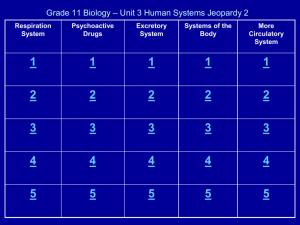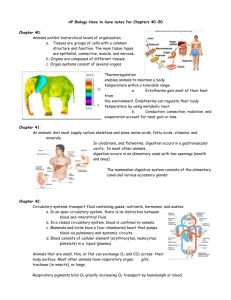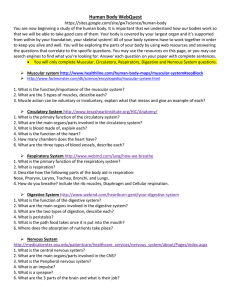BIOS 2150 Review Problems Part 1
advertisement
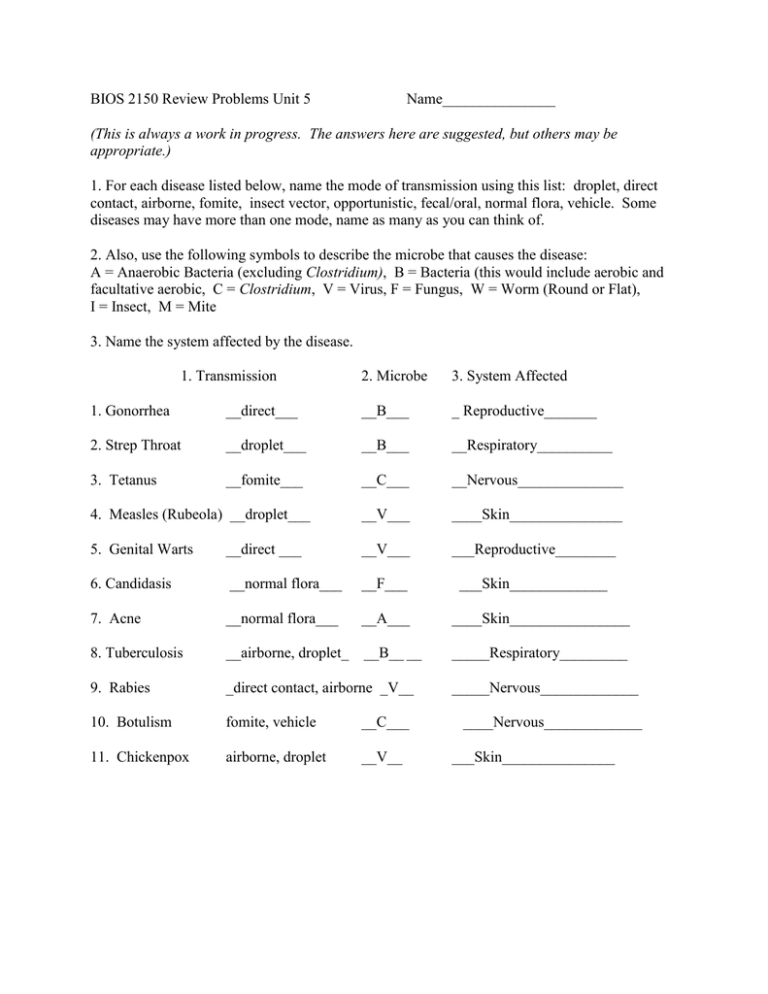
BIOS 2150 Review Problems Unit 5 Name_______________ (This is always a work in progress. The answers here are suggested, but others may be appropriate.) 1. For each disease listed below, name the mode of transmission using this list: droplet, direct contact, airborne, fomite, insect vector, opportunistic, fecal/oral, normal flora, vehicle. Some diseases may have more than one mode, name as many as you can think of. 2. Also, use the following symbols to describe the microbe that causes the disease: A = Anaerobic Bacteria (excluding Clostridium), B = Bacteria (this would include aerobic and facultative aerobic, C = Clostridium, V = Virus, F = Fungus, W = Worm (Round or Flat), I = Insect, M = Mite 3. Name the system affected by the disease. 1. Transmission 2. Microbe 3. System Affected 1. Gonorrhea __direct___ __B___ _ Reproductive_______ 2. Strep Throat __droplet___ __B___ __Respiratory__________ 3. Tetanus __fomite___ __C___ __Nervous______________ 4. Measles (Rubeola) __droplet___ __V___ ____Skin_______________ 5. Genital Warts __direct ___ __V___ ___Reproductive________ 6. Candidasis __normal flora___ __F___ ___Skin_____________ 7. Acne __normal flora___ __A___ ____Skin________________ 8. Tuberculosis __airborne, droplet_ __B__ __ _____Respiratory_________ 9. Rabies _direct contact, airborne _V__ 10. Botulism fomite, vehicle __C___ 11. Chickenpox airborne, droplet __V__ _____Nervous_____________ ____Nervous_____________ ___Skin_______________ Transmission 12. Herpes Simplex 1 _direct, fomite____ 13. Rheumatic Fever __droplet___ Microbe _V____ __B___ System Affected _Skin________________ ____Circulatory______ 14. Head Lice _direct contact__ __I___ ____Skin______________ 15. “Scalded Skin” _direct, fomite, droplet __B__ ____Skin______________ 16. Ringworm _direct, fomite __F___ ___Skin________________ 17. Polio _fecal-oral ___V__ ____Nervous________ 18. Meningitis _droplet___ __B___ 19. Gangrene __ opportunist___ 20. Trichinosis __fecal-oral___ 21. Whooping Cough __droplet___ __C___ _Nervous______________ _Circulatory_____________ __W___ ___Digestive________________ __B__ ____Respiratory____________ 22. Hepatitis B _contact, fomite____ __V___ _____Digestive____________ 23. Hepatitis A __fecal-oral, vehicle_ ___V__ _______Digestive____________ 24. Cold ____Respiratory______________ 25. Encephalitis _airborne, droplet &_ __V___ fomite __vector___ _V____ 26. Mononucleosis __direct, fomite___ ___Nervous__________________ __V___ _______Circulatory_______ 27. Rocky Mountain Spotted Fever __vector___ ___B__ __Circulatory_______________ 28. Lyme Disease __B___ _____Circulatory__________ __vector___ 29. Name a skin disease that is not transmitted by fomite. (more than 1 answer possible) Suggested answers: Acne, measles, rubella, chickenpox, 30. Name a skin disease that moves into the nervous system. (2 answers possible) Herpex simplex I, chicken pox 31. Name a disease of the nervous system that is transmittable from person to person (several are possible) Suggested: Meningitis, conjunctivitis, polio 32. Name a disease of the nervous system that produces a toxin that resides in the synapse. (2 answers possible) Tetanus and botulism 33. Name a disease of the circulatory system that damages heart valves. Rheumatic fever. (Caused by Streptococcus, which is a resident of the throat). 34. Name a disease of the nervous system that enters through the digestive system. Polio and botulism 35. Name a disease of the reproductive system that hides in the nervous system. Herpes simplex II or syphilis 36. Name 2 diseases that show some form of effect on skin that are not diseases of skin. (several answers are possible) Suggested: Syphilis, herpes simplex II (genital herpes) , Lyme disease, scarlet fever, Rocky Mountain spotted fever,
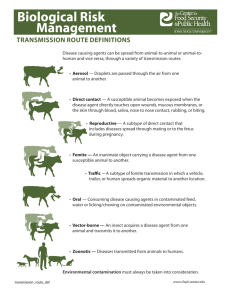
![Agenda 6th grade Week 4 Feb11-Feb 15 (Recovered) [1/7/2013]](http://s2.studylib.net/store/data/009923173_1-8ceb8251ce828253af63dd0db5afcd59-300x300.png)
